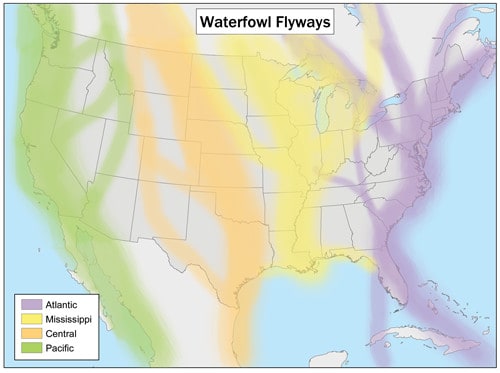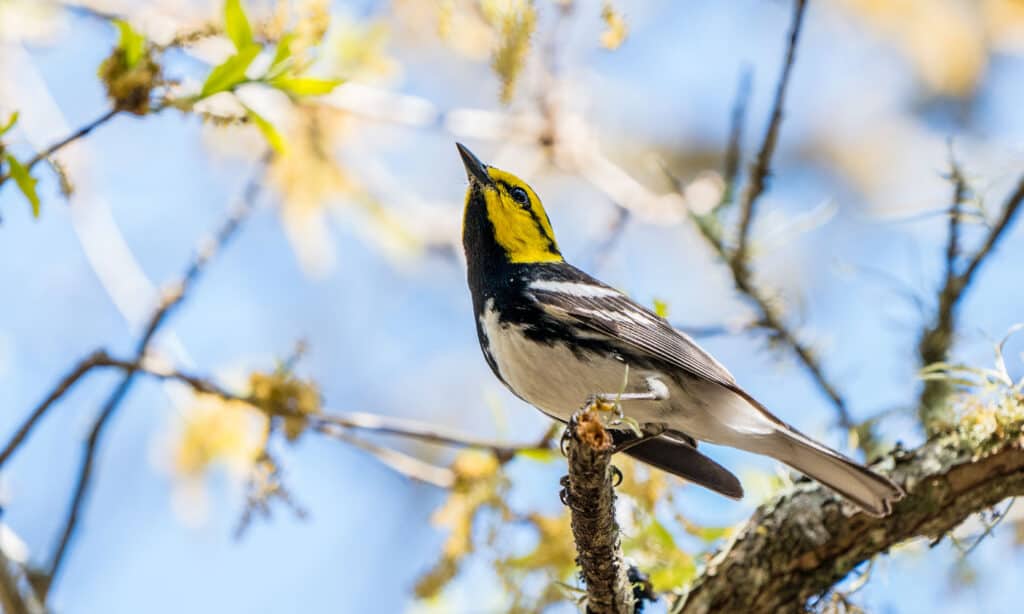North America has four migratory bird flyways, one running down the continent’s middle. These flyways are generally used to connect birds with their preferred northern nesting grounds and their southerly warm spots where they spend their winters. What is the Central Flyway? Why it’s important and the birds that use it are explored in detail.
What Is the Central Flyway?

Migrating birds use four major flyways in the United States.
©This image or recording is the work of a U.S. Fish and Wildlife Service employee, taken or made as part of that person’s official duties. – License
The Central Flyway is the largest of four North American flyways by land area migratory bird species use. While four distinctions are made between flyways in the United States, these are loosely defined paths that aren’t strictly adhered to by all birds that use them. The Central Flyway gets its name from the fact that it is the flyway that covers the center of North America.
Where Is the Central Flyway?
The Central Flyway is in the North American continent’s center, including the western part of the Gulf Coast, the eastern part of the Southwest, most of the Great Plains, and the Rocky Mountains. It starts in Canada’s prairies and continues south of the United States into South America.
The states within the United States that are part of the Central Flyway include:
As it traverses the United States, the Central Flyway bottlenecks in the middle and is wider in the north and south. In and around Nebraska, it funnels into its thinnest point. It becomes wider as it reaches Oklahoma and into Texas.
Why Is the Central Flyway Important?

Aransas Bay in Texas is part of the Central Flyway and one of the last wintering spots left for wild whooping cranes.
©Danita Delimont/Shutterstock.com
The Central Flyway is important because it is a major migratory corridor for birds due to the lack of obstacles and the resources available as they fly across North America. These resources include food, water, and appropriate habitats for resting and nesting.
The Aransas and San Antonio Bays in Texas are conservation hotspots along the Central Flyway. It is the only wintering spot left for North America’s last wild whooping crane flock.
The Prairie Potholes in the upper Great Plains stretching between Canada and the United States supports the breeding territory of over 15 duck species. More than 70 percent of America’s mallards begin their lives here, and over 50 percent of the waterfowl in North America are hatched in this spot on the Central Flyway.
The Central Flyway is a prime hunting corridor for humans. Birds in abundance, like Canada geese and various ducks, are easily harvested by hunters during yearly migrations.
Despite the abundance of game birds, the destruction of wetland habitats is causing hundreds of millions of dollars in economic consequences. That’s because hunting is harder, viewing the birds is more difficult, and farmland replacing these wetlands doesn’t produce as much revenue as birding activities.
What Birds Use the Central Flyway?

Golden-cheeked warblers are one of the bird species that use the Central Flyway in North America.
©Michael Armentrout/Shutterstock.com
Some of the birds that use the Central Flyway in North America include:
- American Bitterns (Botaurus lentiginosus)
- American Coots (Fulica americana)
- American Golden Plovers (Pluvialis dominica)
- Baird’s Sparrows (Ammodramus bairdii)
- Black Capped Vireos (Vireo atricapilla)
- Black Terns (Chlidonias niger)
- Brown Capped Rosy-Finches (Leucosticte australis)
- Buff Breasted Sandpipers (Tryngites subruficollis)
- Canada Geese (Branta canadensis)
- Chestnut Collared Longspurs (Calcarius ornatus)
- Golden Cheeked Warblers (Setophaga chrysoparia)
- Greater Sage Grouses (Centrocercus urophasianus)
- Greater White-Fronted Geese (Anser albifrons)
- Green Winged Teals (Anas carolinensis)
- Harris’s Sparrows (Zonotrichia querula)
- Lesser Scaups (Aythya affinis)
- Lesser Snow Geese (Anser caerulescens)
- Long Billed Curlews (Numenius americanus)
- Mallards (Anas platyrhynchos)
- Mourning Doves (Zenaida macroura)
- Northern Pintails (Anas acuta)
- Pied Billed Grebes (Podilymbus podiceps)
- Reddish Egrets (Egretta rufescens)
- Redheads (Aythya americana)
- Red Knots (Calidris canutus)
- Roseate Spoonbills (Platalea ajaja)
- Sandhill Cranes (Grus canadensis)
- Solitary Sandpipers (Tringa solitaria)
- Snowy Owls (Bubo scandiacus)
- Snowy Plovers (Charadrius nivosus)
- Tri-Colored Herons (Egretta tricolor)
- Tundra Swans (Cygnus columbianus)
- Upland Sandpipers (Bartramia longicauda)
- Whooping Cranes (Grus americana)
- Yellow Billed Cuckoos (Coccyzus americanus)
Why is Nebraska’s Platte River So Important to the Central Flyway?

Most of North America’s sandhill cranes rely on the Platte River as a staging site.
©Joseph Sohm/Shutterstock.com
The Platte River in Nebraska is essential to the Central Flyway because it provides a vital stopover point for migrating birds. After the confluence of the North and South Platte Rivers in Colorado, the main Platte River in Nebraska turned into a braided watercourse that created shallow and muddy wetlands.
Almost 80 percent of North America’s sandhill cranes rely on the Platte River as a staging site during their migration. This means that over half a million cranes congregate in one spot. Over 10 million geese and ducks join them. All of these birds head toward the same 80-mile expanse of the river every year.
Over 300 bird species take advantage of Nebraska’s stretch of the Platte River. Also, more than 140 species of birds use this area as their nesting grounds.
As valuable as the Platte River is, the ecosystem is on the verge of irreversible destruction. Since the arrival of the first white settlers, human activity has changed the watercourse. Today, it is a sliver of what it was historically.
This has adversely affected vegetation, limiting the food supplies needed by stopover species. Also, flood control measures along the river have stopped floods, allowing shore plants to grow unhindered next to the water when they would have been washed away annually. This diminishes the sandbars needed by many species and effectively displaces these birds.
The photo featured at the top of this post is © Krasula/Shutterstock.com
Thank you for reading! Have some feedback for us? Contact the AZ Animals editorial team.






